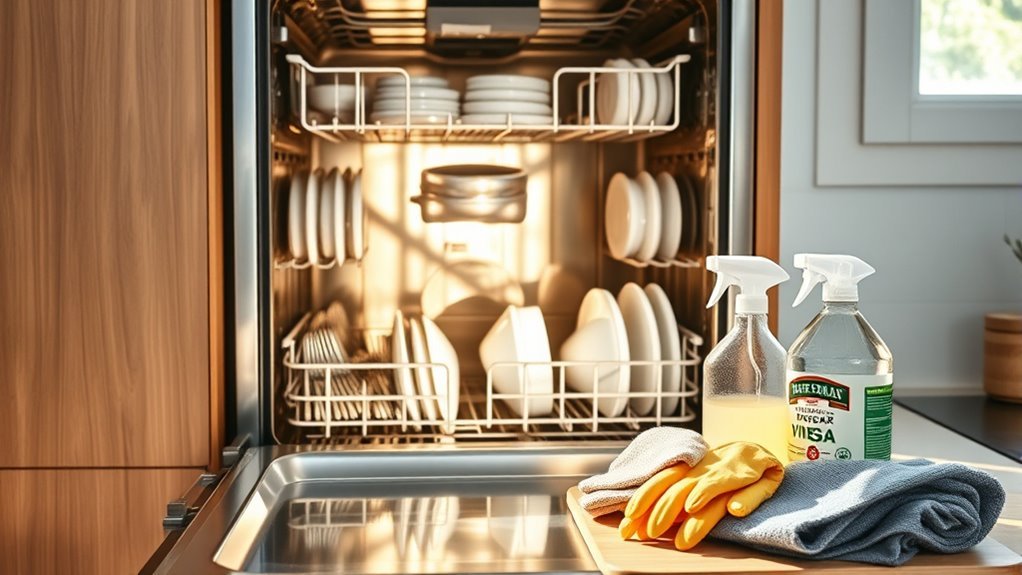Spring Cleaning Guide for Dishwasher
For your spring dishwasher cleaning, start by emptying it and removing filters to rinse away debris. Check spray arms for clogged holes and clean them carefully. Wipe down door seals and the exterior to prevent mold and grime buildup. Run a hot vinegar cycle to break down mineral deposits, and sprinkle baking soda to neutralize odors. Don’t forget to clear the drainage system for smooth operation. Keep up this routine and you’ll find even more ways to keep your dishwasher running fresh and efficient.
Preparing Your Dishwasher for Cleaning

Before you begin cleaning, you’ll want to prepare your dishwasher properly to guarantee the process is effective. Start by emptying the dishwasher completely, ensuring no dishes or utensils remain. Check and remove any large debris from the bottom to prevent clogging. Following dishwasher maintenance tips, inspect the spray arms and door seals for buildup or damage. This prep helps your cleaning efforts reach every nook efficiently. Remember, cleaning frequency recommendations suggest tackling this task every one to three months, depending on usage. By sticking to a routine, you’ll keep your dishwasher running smoothly and avoid unexpected breakdowns. Taking these simple steps gives you the freedom to enjoy spotless dishes without hassle, making your spring cleaning truly rewarding.
Removing and Cleaning the Dishwasher Filters
Once your dishwasher is prepped, the next step is to focus on the filters, which play a key role in trapping food particles and preventing clogs. You’ll find different filter types, like manual or self-cleaning, so check your model before removing them. To maintain your dishwasher’s efficiency and enjoy freedom from stubborn residues, take the filters out carefully. Rinse them under warm water, using a soft brush to clear away debris without damaging delicate mesh screens. Regular filter maintenance not only prevents odors but also boosts your dishwasher’s performance. Make it a habit to clean your filters monthly or more often if you run heavy loads. This simple step keeps your appliance running smoothly, giving you more time to enjoy life, not worry about chores.
Inspecting and Cleaning the Spray Arms

Now it’s time to remove the spray arms to check for clogs or debris blocking the water flow. Carefully clear any buildup to guarantee they spin freely and spray effectively. Once cleaned, reinstall the arms and run a test cycle to confirm everything’s working properly.
Removing Spray Arms
Start by carefully removing the spray arms from your dishwasher to get a clear look at any buildup or blockages. Proper spray arm maintenance is essential for ideal cleaning performance and water flow. Here’s how you can handle spray arm cleaning with ease:
- Check your dishwasher’s manual for specific removal instructions.
- Gently twist or unscrew the spray arms; avoid forcing them to prevent damage.
- Inspect the spray holes for mineral deposits or grime.
- Soak the spray arms in warm, soapy water to loosen debris.
Clearing Clogs and Debris
Although removing the spray arms is an important first step, you’ll need to carefully clear any clogs or debris blocking the holes to guarantee proper water flow. Start by inspecting each hole closely—tiny food particles or mineral buildup can restrict spray patterns, reducing cleaning power. Use a toothpick or a small brush to gently remove any stubborn debris. Rinsing the spray arms under warm water helps flush out loosened particles, supporting effective debris management. Regularly tackling these blockages is key to clog prevention, ensuring your dishwasher runs efficiently without interruptions. By maintaining clear spray arms, you reclaim control over your appliance’s performance, freeing yourself from hassle and costly repairs. This simple step empowers you to keep your dishwasher operating smoothly all year long.
Reinstalling and Testing
After clearing any clogs and debris from the spray arms, you’ll want to carefully reinstall them to guarantee they fit securely and function properly. Reinstalling dishwasher spray arms is key to maintaining your appliance’s efficiency and your freedom from hand washing. Follow these steps to verify smooth testing functionality:
- Align the spray arms onto their mounting points without forcing them.
- Secure any locking mechanisms or screws to hold the spray arms firmly.
- Rotate the spray arms manually to check for free movement.
- Run a short cycle to observe water distribution and confirm everything works.
Wiping Down the Door Seals and Exterior

When you’re done cleaning the interior, don’t forget to wipe down the door seals and exterior to keep your dishwasher looking fresh and functioning properly. Focus on door gasket maintenance by gently cleaning the rubber seals with a damp cloth to remove food particles and prevent mold buildup. This simple step guarantees a tight seal, avoiding leaks and preserving energy efficiency. Next, give the exterior a quick wipe with a mild cleaner or soapy water, then polish it dry to restore that exterior shine. Keeping the outside spotless not only enhances your kitchen’s look but also protects the finish from grime and fingerprints. Regular attention to these parts frees you from future headaches, making your dishwasher a reliable, sleek machine for all your cleaning needs.
Dealing With Hard Water Deposits
Hard water deposits can build up quickly inside your dishwasher, affecting its performance and leaving spots on your dishes. Tackling these stubborn mineral buildups doesn’t have to be a chore. You’ve got the freedom to keep your dishwasher running smoothly with a few smart steps:
- Use specialized cleaning solutions designed to break down hard water deposits.
- Regularly check and clean the spray arms to prevent clogging from mineral residue.
- Wipe down the interior surfaces, focusing on areas where deposits tend to gather.
- Rinse filters thoroughly to remove trapped hard water particles.
Running a Vinegar Wash Cycle
Although mineral deposits can be stubborn, running a vinegar wash cycle is a simple and effective way to dissolve buildup and freshen your dishwasher. You don’t need fancy products—just place a cup of white vinegar in a dishwasher-safe container on the top rack. Run a hot water cycle without any detergent or dishes. This process taps into the vinegar benefits: it breaks down grease, mineral deposits, and grime, restoring your dishwasher’s efficiency. For the best results, consider the cycle frequency; doing this once a month keeps your dishwasher running smoothly and odor-free. Embracing this routine gives you freedom from harsh chemicals and costly repairs, letting you enjoy a cleaner appliance with minimal effort.
Using Baking Soda for Odor Removal
A simple cup of baking soda can work wonders in eliminating odors from your dishwasher. As a natural odor neutralizer, baking soda refreshes your appliance without harsh chemicals. Just sprinkle it across the bottom of the dishwasher and run a short, hot wash cycle. This straightforward step helps you maintain a fresh, clean environment for your dishes.
Here’s why baking soda is your go-to for odor removal:
- Neutralizes sour and musty smells effectively
- Safe for your dishwasher’s interior and the environment
- Affordable and readily available in most households
- Easy to use, requiring no extra tools or products
Embrace this simple, natural solution and enjoy a dishwasher that smells as free as you do.
Checking and Clearing the Drainage System
Now’s a great time to check your dishwasher’s drain filters for any trapped debris. You’ll want to remove any clogs carefully to keep the drainage system running smoothly. This simple step helps prevent backups and keeps your dishwasher working efficiently.
Inspecting Drain Filters
Before you plunge into cleaning your dishwasher, take a moment to inspect the drain filters. These small but mighty components keep your dishwasher running smoothly by catching food particles and debris. Regular attention to your drain filter is one of the best maintenance tips to avoid blockages and unpleasant odors.
Here’s how to keep it clear and free-flowing:
- Remove the drain filter carefully according to your model’s instructions.
- Rinse it under warm water, using a soft brush to clear trapped debris.
- Check the filter housing for build-up that could impede drainage.
- Reinstall the filter securely to maintain peak performance.
Taking these simple steps guarantees your dishwasher stays hassle-free, giving you the freedom to enjoy clean dishes without worry.
Removing Clogs Safely
Once you’ve given the drain filters a thorough cleaning, it’s important to check the entire drainage system to make sure there aren’t any hidden clogs. Start by inspecting the drain hose for bends or debris that could block water flow. Detach it carefully, and look inside for buildup. Using a flexible brush or a gentle water stream, clear out any obstructions. Remember, safe unclogging means avoiding harsh chemicals that can damage your dishwasher or the environment. Instead, opt for natural solutions like vinegar or baking soda if needed. Regularly checking this system is key for clog prevention, ensuring your dishwasher runs smoothly and efficiently. Taking these steps gives you the freedom to enjoy spotless dishes without worrying about blockages slowing you down.
Tips for Maintaining a Clean Dishwasher Longer
Although a thorough spring cleaning resets your dishwasher, maintaining its cleanliness requires consistent care. To keep your machine running smoothly and fresh, focus on regular maintenance and proper loading. These habits prevent buildup and promote efficiency.
Here are tips to help you maintain a clean dishwasher longer:
- Rinse dishes before loading to avoid food residue buildup.
- Load items properly, ensuring spray arms rotate freely.
- Run an empty cycle with vinegar monthly to dissolve grime.
- Clean the filter regularly to prevent clogs and odors.
Frequently Asked Questions
Can I Use Bleach to Clean My Dishwasher?
Thinking of baptizing your dishwasher in bleach? Sure, if you want to risk corrosion and funky smells! Instead, you’d be way smarter choosing bleach alternatives like white vinegar or baking soda for safe cleaning. These keep your dishwasher fresh without turning it into a chemical war zone. You deserve freedom from harsh chemicals, so go gentle—your appliance will thank you, and you’ll avoid any unwanted bleach drama!
How Often Should I Replace Dishwasher Racks?
You should replace your dishwasher racks when you notice significant wear or rust, usually every 3-5 years, depending on rack durability. Regular dishwasher maintenance helps extend their life, but freedom from constant repairs means swapping them out sooner if damage affects cleaning or safety. Keep an eye on the coating peeling or bent tines, and don’t hesitate to replace racks to keep your dishwasher running smoothly and hassle-free.
Is It Safe to Run the Dishwasher Empty?
Running your dishwasher empty is like taking your car out for a spin without passengers—it’s perfectly safe and helps keep things running smoothly. Using an empty cycle occasionally is great for dishwasher maintenance; it clears out residue and refreshes the system. Just add a dishwasher cleaner or vinegar to boost effectiveness. So, don’t hesitate to run empty cycles—they’re a simple way to keep your dishwasher free and clear!
What Detergents Are Best for Eco-Friendly Dishwashers?
When choosing detergents for eco-friendly dishwashers, you’ll want to go for biodegradable detergents that break down naturally without harming the environment. Natural alternatives like those made from plant-based ingredients or enzymes work great and keep your dishes clean without harsh chemicals. You don’t have to sacrifice power for eco-friendliness—these options give you the freedom to care for your home and the planet at the same time.
Can Dishwasher Cleaning Improve Energy Efficiency?
Ever wondered if a clean dishwasher could actually save you money on energy bills? It sure can! By following simple maintenance tips like regularly cleaning filters and spray arms, you guarantee your dishwasher runs smoothly and uses less energy. This means energy savings without sacrificing performance. Keeping your appliance in top shape not only frees you from costly repairs but also helps you enjoy more freedom with lower utility costs—win-win!






